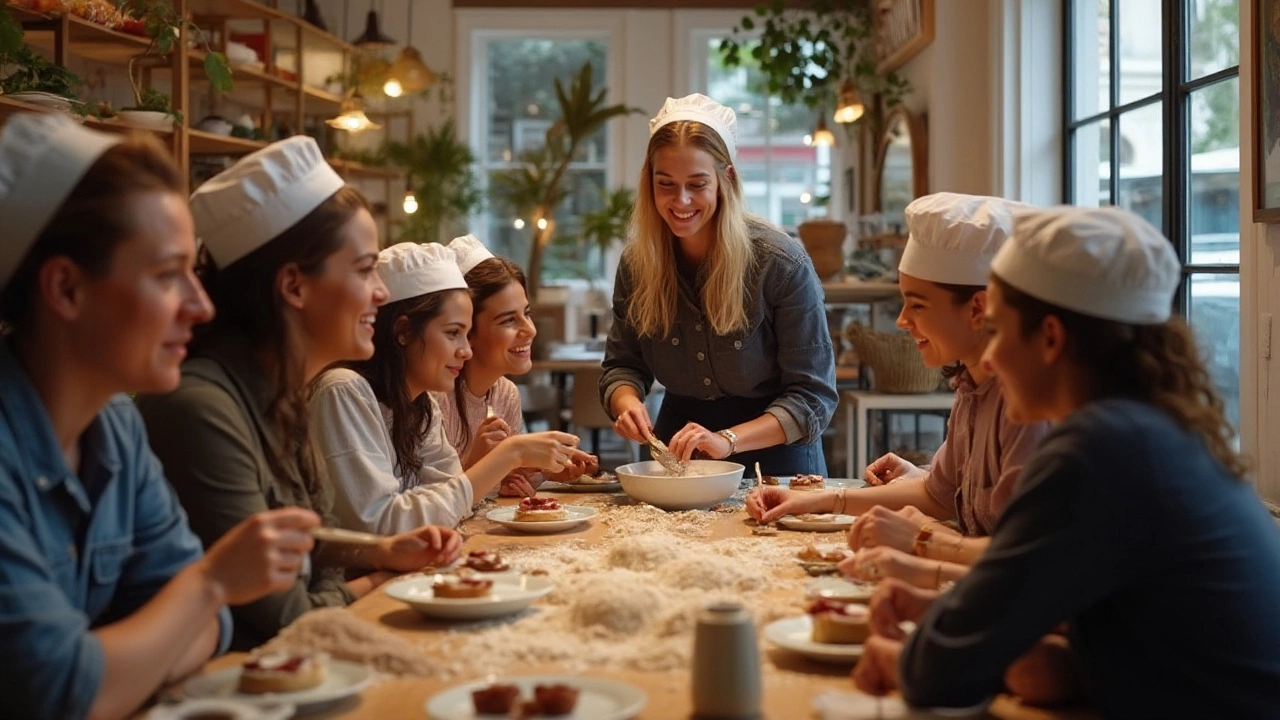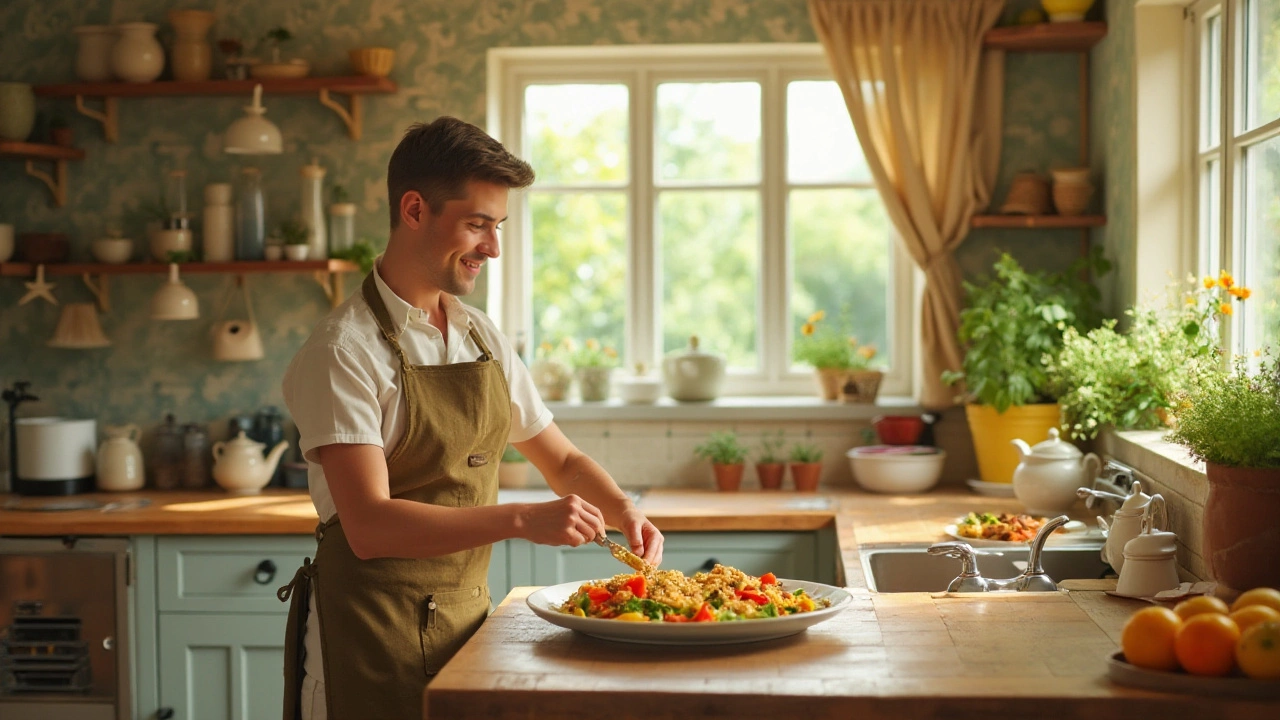Embarking on a gluten-free journey can seem daunting, yet it uncovers a vibrant world of flavors and ingredients. For individuals with gluten intolerance or those choosing a gluten-free lifestyle, it's crucial to know what foods can be safely enjoyed.
In this exploration, we delve into naturally gluten-free foods, where ancient grains play a star role. These healthy staples often offer nutritional benefits that go beyond being gluten-free.
Alongside traditional ingredients, the creative use of modern gluten-free alternatives opens doors to endless culinary possibilities. Whether you're seeking inspiration for new recipes or ways to integrate gluten-free options into family meals, this guide aims to lead you there.
- Understanding Gluten-Free Basics
- Naturally Gluten-Free Foods
- Creative Gluten-Free Cooking Tips
- Incorporating Gluten-Free Foods into Everyday Meals
Understanding Gluten-Free Basics
Entering the world of a gluten-free lifestyle can initially appear complex, yet it's crucial to start by understanding what gluten actually is. Gluten is a protein composite found largely in grains such as wheat, barley, and rye. It's responsible for giving baked goods their chewy texture, making it a common staple in everyday diets. Unfortunately, for individuals with celiac disease or non-celiac gluten sensitivity, consuming gluten can lead to a variety of uncomfortable symptoms, from digestive issues to joint pain and even neurological symptoms. Embracing a gluten-free diet is not just about avoiding bread and pasta but a complete lifestyle shift involving thorough attention to ingredients.
One fascinating aspect of embarking on this journey is discovering the sheer variety of gluten-free foods naturally available. Did you know that certain grains, like quinoa and rice, are completely gluten-free and come packed with nutrients? Beyond grains, fruits, vegetables, legumes, nuts, and seeds are naturally free from gluten and essential components of a balanced diet. Evolving global culinary trends have expanded the pantry of gluten-free eaters to include foods from different cultures, offering both variety and flavor.
Understanding labels and food processing is another vital skill for those on a gluten-free diet. Due to cross-contamination, some processed foods may contain trace amounts of gluten even if they appear gluten-free. Labels that carry 'certified gluten-free' marks are rigorously tested to ensure they meet safe consumption standards for those extremely sensitive to gluten.
“The challenge with gluten is that even minute traces can have significant effects on those with severe sensitivities,” says Jane Smith, a renowned nutritionist and author on dietary health.Armed with this knowledge, people can make informed decisions when shopping, ensuring their kitchen is stocked with safe, gluten-free options.
Statistics suggest that around 1% of the global population is affected by celiac disease, while a notable percentage also experiences non-celiac gluten sensitivity. With these numbers in mind, the rise of the gluten-free food market comes as no surprise, now estimated to be worth billions of dollars annually. This market growth has encouraged food manufacturers to create innovative gluten-free recipes, ranging from pastries to pasta, ensuring that those with gluten sensitivities don't miss out on their favorite foods. Striking a balance between taste and health is the new norm for gluten-free products.

Naturally Gluten-Free Foods
When embarking on a journey toward a gluten-free lifestyle, the foundation lies in embracing foods that are naturally devoid of gluten. The world of naturally gluten-free foods is vast, brimming with nutritious and delicious options that are both safe and satisfying. Grains and seeds like quinoa, millet, and buckwheat often take center stage. Quinoa, for instance, is a powerhouse of protein and essential amino acids, making it not only a superb replacement for traditional gluten-containing grains but also a wholesome source of sustenance. Millet, another ancient grain, is gentle on the digestive system and versatile enough to be used in everything from porridges to baked goods.
Buckwheat, despite its name, is unrelated to wheat and is entirely gluten free. Rich in fiber and nutrients, it can be used in pancakes or as an exciting alternative to rice. Aside from grains, fruits and vegetables proudly hold the title of naturally gluten-free foods. Fruits like apples and berries, alongside vegetables such as sweet potatoes and leafy greens, offer a vibrant array of vitamins and antioxidants. Enjoying a colorful variety ensures a balanced intake of nutrients, promoting overall health and well-being.
Additionally, protein sources like beans, legumes, and nuts are distinctively gluten-free and provide excellent sources of energy and nutrition. Lentils, chickpeas, and almonds are just a few examples. Incorporating these into your diet not only enriches it with essential nutrients but also aids in maintaining a healthy digestive tract.
Sometimes it is intriguing to explore historical contexts too. Certain cultures have relied on gluten-free staples for generations. In Asian cuisine, rice and rice-based products are staple choices. In Africa, teff—an ancient grain used to make injera—remains a nutritive cornerstone.
According to Dr. William Davis, 'Turning to these ancient grains is similar to returning to our culinary roots—a movement toward real, wholesome foods.'Embracing naturally gluten-free choices provides more than just a diet—it offers a passport to culinary exploration across cultures and times.
Integrating these naturally gluten-free foods is simpler than it seems, yet it's pivotal to always check food labels when shopping, as some seemingly naturally gluten-free foods could be processed in facilities that handle gluten. Luckily, many brands now cater to gluten-free needs, offering assurance that their products are indeed safe for consumption.
To aid your transition, here's a brief list of naturally gluten-free foods to incorporate into your daily menu:
- Quinoa
- Millet
- Buckwheat
- Rice
- Fruits (apples, berries, bananas)
- Vegetables (spinach, carrots, broccoli)
- Legumes (beans, chickpeas, lentils)
- Nuts (almonds, walnuts, cashews)
The diversity in textures and flavors these foods bring to your plate is worth exploring. Whether you are crafting a vibrant quinoa salad or blending a nutrient-packed smoothie with leafy greens and berries, these naturally gluten-free choices ensure that every meal is both healthful and bursting with flavor. The journey into gluten-free living, without doubt, promises not only improved health but also an enriched culinary adventure.

Creative Gluten-Free Cooking Tips
When embarking on the culinary adventure of gluten-free cooking, creativity is your best ally. It’s essential to familiarize yourself with the gluten-free ingredients that are not just substitutes but also elevate the flavor and texture of dishes. One exciting avenue to explore is the use of ancient grains, such as quinoa, amaranth, and millet. These grains not only mimic some of the properties of traditional wheat-based ingredients but often provide a more robust nutritional profile, boasting higher protein and fiber content. Experimenting with these grains can lead to delightful surprises, adding an unexpected twist to your meals. Moreover, give buckwheat a chance; despite its misleading name, it is entirely gluten-free and makes a hearty addition to salads and side dishes.
Diving deeper into ancient grains offers the bonus of cultural experience. Incorporating them into just a few meals a week can bring global flavors into your home. The flexible nature of gluten-free diets makes it possible to celebrate these ingredients in savory dishes such as pilafs and porridge, especially when you embellish them with herbs and vegetables. Let’s not forget nettle or sorrel, both unique yet underutilized herbs that bring a refreshing zing to any gluten-free dish. As the chef and food writer, Julia Child, once said,
"Find something you're passionate about and keep tremendously interested in it."The world of gluten-free cooking is vast; stay curious and open to trying new flavors and ideas.
Innovation isn't just about ingredients; technique plays a vital role too. Finding the balance of moisture and binding can be challenging in gluten-free baking, where wheat's elastic gluten structure is absent. Enter xantham gum and psyllium husk – these are magical in their ability to mimic gluten’s binding properties. They allow your baked goods, like bread and muffins, to maintain the much-desired fluffiness. An often underappreciated secret weapon, applesauce can also work wonders as a moistening agent, ensuring cookies stay chewy and delightful. Adding these elements ensures that gluten-free options are not just a compromise but a highlight on the dessert table.
Another intriguing method to boost your gluten-free cooking is to blend different flours. No single flour can capture all the qualities of wheat, but a combination can get you surprisingly close. Try mixing almond flour with coconut flour for a rich, nutty flavor, while rice flour can lighten the texture, suited perfectly for pancakes and waffles. For breading your favorite proteins, consider using cornstarch or potato starch for a crispy, tantalizing crust that rivals any traditional breadcrumb. To ensure your creations have a broad appeal, always incorporate diverse textures and flavors. It's these little innovations and combinations that can transform your experience, proving that gluten-free options can be just as satisfying, if not more so, than their gluten-laden counterparts.

Incorporating Gluten-Free Foods into Everyday Meals
Integrating gluten-free foods into daily meals isn't just a diet choice for those with celiac disease or gluten intolerance; it's a delicious exploration of diverse and nutritious ingredients. The journey begins with understanding staple gluten-free options and how they can replace or enhance traditional ingredients. Quinoa, for instance, known as the "mother of all grains," has more protein than most grains and is naturally gluten-free, making it a powerhouse for salads, soups, and as a side dish.
Starting your day with a gluten-free breakfast sets a positive tone. Replace wheat-based cereals with options like chia pudding, prepared from chia seeds known for their omega-3 fatty acid content. These tiny seeds can soak up liquid and expand, creating a satisfying texture perfect for layering with fruits and nuts. For those who enjoy traditional bread, experiment with gluten-free flour blends made from almond or coconut flour, which can be used to make pancakes and waffles. Not only are these tasty, but they provide additional health benefits, such as essential minerals and reduced carbs.
Lunches and dinners offer further avenues for incorporating gluten-free foods. Imagine a vibrant bowl of stir-fry made with tamari, a gluten-free soy sauce alternative, which adds depth to your dish without compromising on taste. Include vegetables like (1) bell peppers, (2) broccoli, and (3) snap peas, and protein from tofu or chicken, and serve it over brown rice or shirataki noodles, which are both naturally gluten-free and complement the flavors beautifully. For pasta enthusiasts, gluten-free pasta options made from legumes such as chickpeas or lentils are available. These not only mimic traditional pasta in taste and texture but also pack double the protein and fiber.
Desserts and snacks can also be gluten-free delights. Flourless chocolate cakes, often made with almond meal, create a decadent dessert experience. Additionally, experimenting with different nut butters, fruits, and seeds can lead to the discovery of wonderfully satisfying snacks. Even munching on plain popcorn popped in coconut oil can become a favorite treat, as popcorn is inherently gluten-free.
The key to a successful transition lies in planning and experimenting with flavors until you find combinations that your taste buds adore. Label reading becomes a necessary skill, not only for detecting hidden gluten but for discovering new favorite items in the supermarket aisles. And remember, as chef and author Nigella Lawson says, "It’s not just about choosing foods that are gluten-free; it’s about enjoying the adventure of the incredible variety that a gluten-free lifestyle offers." Embrace this chance to reimagine meals, infusing them with creativity and health.

